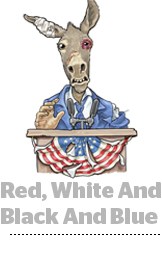 A year ago, the Democratic Party data-driven ecosystem, a network of consultants, liberal digital media agencies and campaign tech vendors, was confident it would hold the White House, flip the Supreme Court and maybe even reclaim a Senate majority.
A year ago, the Democratic Party data-driven ecosystem, a network of consultants, liberal digital media agencies and campaign tech vendors, was confident it would hold the White House, flip the Supreme Court and maybe even reclaim a Senate majority.
Now, there is a sense of urgency as Democrats up and down ballots seek to reclaim the digital advantage they once had – despite their reluctance to invest in digital.
Digital media was home court for Democrats over the early 2000s, with influential liberal bloggers and the Obama campaign structure setting the pace on data and fundraising, said Jim Walsh, co-founder and CEO of the Democrat-aligned programmatic tech firm DSPolitical.
“But that’s changed on social and digital and we need to respond to it,” Walsh said.
The media mix shifts as decision-makers who believe in digital move up the ladder within campaigns, said Greg Berlin, co-founder of the liberal digital agency Mothership Strategies. “But I think we are at a point now where some folks in the party are still making dangerous decisions to not invest in digital.”
The concern is that Democrats could be washed out in share of online voice since they have less money to spend than Republicans and are spending a far higher percentage of their money on television.
The average Democratic campaign spent 10-15% of its ad budget on digital, and the Clinton campaign spent less than 20% of its budget on digital. The Republican National Committee (RNC), on the other hand, attached a 40% digital spending minimum to the $150 million advertising budget it doled out to Republican campaigns.
The Democratic National Committee (DNC) is hoping to double its outreach budget from $50 million to $100 million as part of its plan to energize liberal data-driven campaigning under Tom Perez, the new DNC chair and former Obama labor secretary. The DNC is also reorganizing itself into pods, such as “communications,” “fundraising” and “organizing,” to meet modern campaign demands.
But without guidance, as the RNC issued last year, allotments from the party won’t necessarily create a surge in digital spending among candidates. Some cash infusions could even work against digital media: If a campaign has $200,000 on hand and needs $300,000 for a potential TV buy, doubling the coffers could lead to more advertising but less digital spending.
Three Democratic fundraisers and party officials said this year they’ve seen donors, primarily from California-based tech executives, attach digital-spending stipulations to contributions.
“It’s the first time I’ve seen a media-based rider like that,” one official said.
A Democratic fundraiser, speaking anonymously to discuss donors, compared it to alumni donating to former colleges with specific demands for how the money could be spent – like on a sport team or specific department.
Donations to liberal causes overall have hit a historic peak, but not for Democratic Party organizations.
Since 2015, the ACLU has gone from the 87th most popular charity to the most popular, according to data compiled by Benevity, a workplace giving and investment software company. Planned Parenthood went from ninth place to third, and Islamic Relief Worldwide entered the top 10.
But those advocacy groups don’t collectively deploy credit card data, contact information and issue-based personalization like Democrats do through candidate or party contributions.
“We don’t really need to be a part of advanced or individual targeting to achieve our goals, and it’s something we’re really careful about because it’s antithetical to some supporters and ACLU positions,” one ACLU official told AdExchanger earlier this year.
NGP VAN, the DNC’s data archive partner and a campaign tech platform that supports liberal campaigns and issue groups, is adopting the DNC’s pod structure, which could help bridge liberal organizers and activists to the tech and data ecosystem, said NGP VAN President and CEO Stu Trevelyan.
Jess O’Connell was appointed DNC chief executive by Perez, and her former role as executive director of the pro-choice fundraising group Emily’s List points to the committee’s renewed vision of itself as a locus for digital thinking and liberal activism.
“There’s a need to de-silo the channels of organizers, fundraisers, canvassers or people doing content and email campaigns,” Trevelyan said. “It’s something you see more on the commercial side when an organization needs to tie a set of ads, emails and real-world interactions to one individual.”
Fortunately for Democrats, candidates haven’t struggled to raise money alongside the donations showered on issue groups. Jon Ossoff massively outraised Republican Karen Handel in his losing bid for a Georgia congressional seat this year, which was the most expensive House campaign ever.
Democratic candidates “still hold a stronger position than Republicans in digital fundraising,” said Berlin, whose agency Mothership managed fundraising and digital media for the Ossoff campaign. But he said that after candidates begin with digital-heavy fundraising drives and email collection, digital ad budgets often don’t crystallize until late in the campaign because persuasion advertising dollars are prioritized for TV.
Walsh said he’s pushing Democrats to ramp up digital persuasion campaigns – which in 2016 consisted almost entirely of TV commercials pressed into YouTube and Facebook video ads.
In previous cycles, willingness to commit creative production resources and ad dollars to digital was “driven up from the bottom by individuals,” said Mike Schneider, a managing director at the liberal digital marketing agency Bully Pulpit interactive. “But now at least we’re starting to see real concern from the top that the macro spend allocations aren’t right.”
This post was syndicated from Ad Exchanger.

More Stories
Warner Bros. Discovery CEO David Zaslav Receives $51.9 Million Pay Package for 2024
TikTok Fave Duolingo Boosts YouTube Shorts Viewership 430% in One Year
Streaming Ratings, Week of March 10: Disney+ Sails to the Top Courtesy of Moana 2